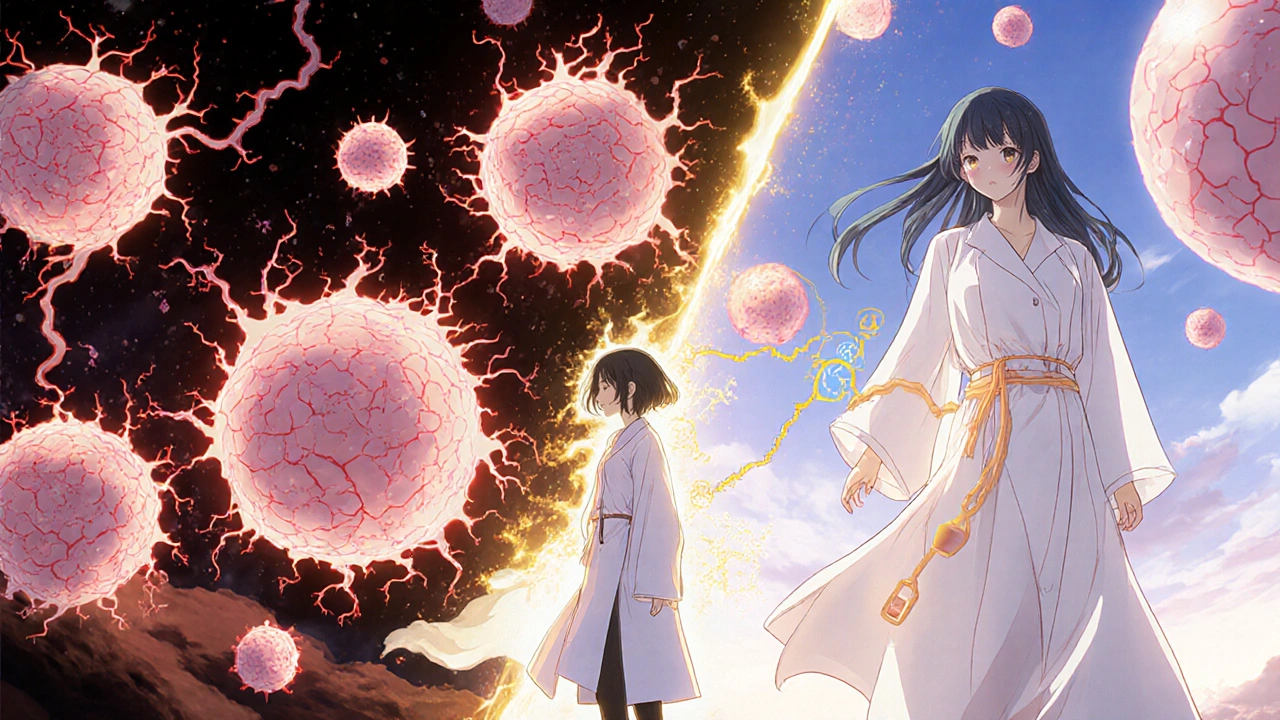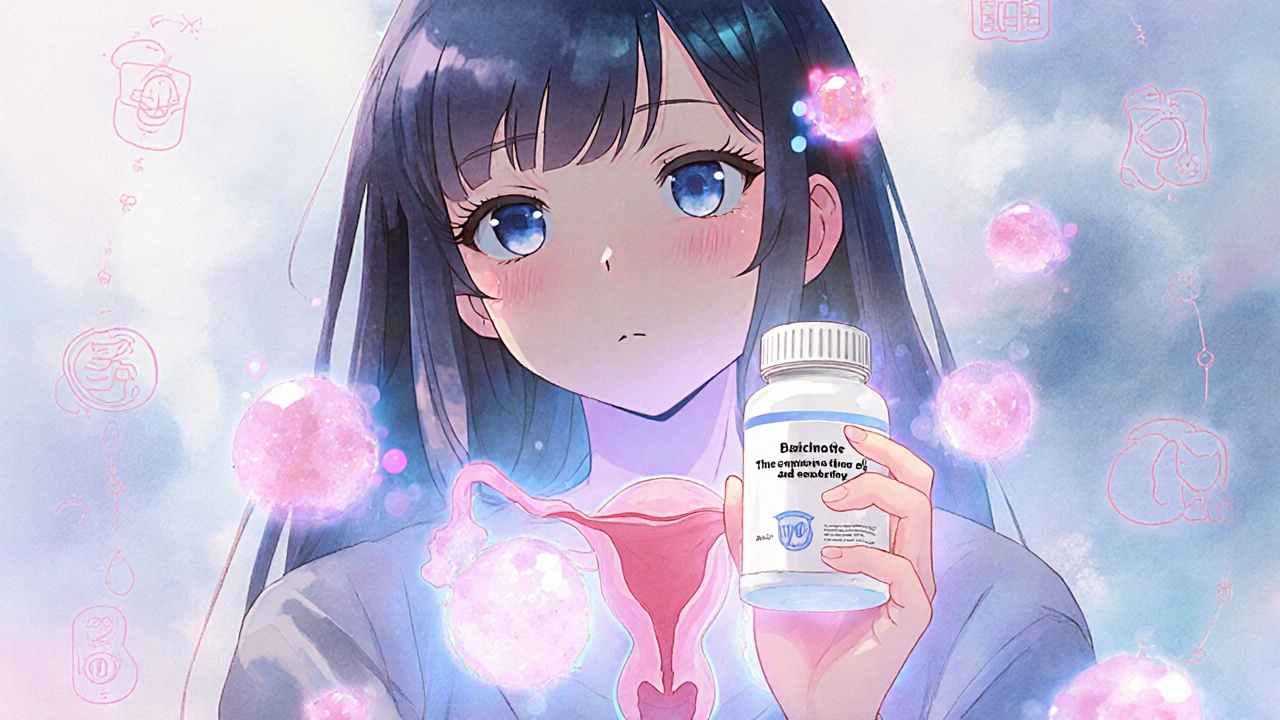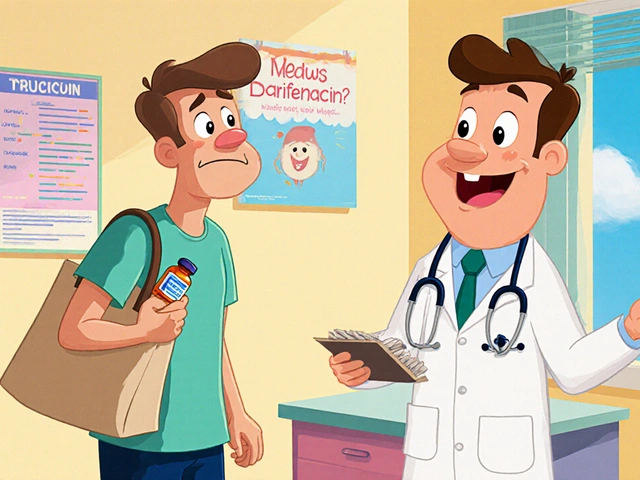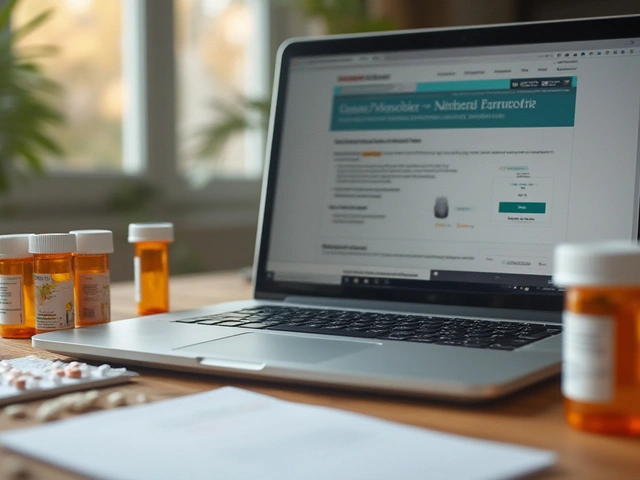Many women take drospirenone-based birth control pills to manage acne, PMS, or irregular periods-but what about ovarian cysts? If you’ve been diagnosed with ovarian cysts and are wondering whether drospirenone helps or hurts, you’re not alone. The truth isn’t simple. Drospirenone doesn’t cure ovarian cysts, but it can change how often they form, how big they get, and whether they cause pain. Here’s what actually happens when you take it.
What is drospirenone?
Drospirenone is a synthetic hormone used in some birth control pills, like Yaz, Yasmin, and Beyaz. It’s not the same as older progestins like levonorgestrel or norethindrone. Unlike those, drospirenone acts like a natural progesterone and also has anti-androgenic properties. That means it can block male hormones like testosterone, which is why it’s often chosen for women with acne or excess hair growth. It also has mild diuretic effects, helping reduce bloating.
It’s always combined with estrogen-usually ethinyl estradiol-in these pills. Together, they prevent ovulation. No ovulation means no follicle grows into a cyst. That’s the key.
How do ovarian cysts form?
Ovarian cysts are fluid-filled sacs that develop on or inside the ovary. Most are harmless and go away on their own. The most common type is the functional cyst, which forms during your normal menstrual cycle. There are two main kinds:
- Follicular cysts: These happen when the follicle (the sac that holds the egg) doesn’t break open to release the egg. Instead, it keeps growing.
- Corpus luteum cysts: These form after the egg is released. The follicle turns into the corpus luteum, but if fluid builds up inside, it becomes a cyst.
These cysts are tied to ovulation. If you ovulate, you can get them. If you don’t, you’re much less likely to.
Does drospirenone prevent ovarian cysts?
Yes-by stopping ovulation.
When you take drospirenone daily, your body doesn’t get the signal to release an egg. No egg release means no follicle rupture, no corpus luteum formation. Without those steps, functional cysts simply can’t form. Studies show that women on combined hormonal contraceptives (including drospirenone) have a 60-80% lower risk of developing new functional cysts compared to those not using hormonal birth control.
That doesn’t mean every cyst disappears. If you already have one when you start the pill, it won’t vanish overnight. But the pill stops new ones from forming. For many women, that’s enough to reduce pain and avoid complications.
What about PCOS and cysts?
Women with polycystic ovary syndrome (PCOS) often have many small cysts on their ovaries-but these aren’t the same as functional cysts. PCOS cysts are immature follicles that never mature enough to release an egg. They’re stuck because of hormonal imbalance, not because of a broken cycle.
Drospirenone helps here too. It lowers androgen levels, which are often too high in PCOS. That can reduce acne, hair growth, and even help regulate periods. While it doesn’t make the cysts disappear, it stops the cycle that makes them worse. Many doctors prescribe drospirenone pills specifically for PCOS because they address both the symptoms and the hormonal root.

Can drospirenone cause ovarian cysts?
No-not directly.
There’s no evidence that drospirenone causes ovarian cysts. In fact, the opposite is true. But some women report new pain or discomfort when they start the pill. Why?
- They might have had a cyst before starting and didn’t know it.
- Changes in hormone levels can cause temporary bloating or cramping as the body adjusts.
- Very rarely, a cyst may form during the placebo week if ovulation slips through-but this is uncommon with consistent use.
If you get sharp, sudden pain in your lower abdomen after starting drospirenone, don’t assume it’s the pill. That could be a ruptured cyst, ovarian torsion, or something else. Call your doctor. But don’t blame the pill without checking.
Who should avoid drospirenone?
Not everyone should take it. Drospirenone can raise potassium levels in the blood. That’s usually fine for healthy people, but it’s risky if you have:
- Kidney disease
- Adrenal insufficiency
- Diabetes with kidney damage
- Are taking potassium-sparing diuretics (like spironolactone or amiloride)
It’s also not recommended if you have a history of blood clots, stroke, heart disease, or uncontrolled high blood pressure. These risks aren’t unique to drospirenone-they apply to all estrogen-containing birth control.
If you’ve had ovarian cysts that ruptured, bled, or twisted in the past, your doctor might still recommend drospirenone to prevent recurrence. But they’ll weigh the benefits against your personal risk profile.
How long does it take to see results?
It takes about 3-6 months for your body to fully adjust. You might notice:
- Less bloating within the first cycle
- Improved acne after 2-3 months
- More regular periods by month 3
- Reduced risk of new cysts after 6 months of consistent use
Don’t expect instant relief. Ovarian cysts don’t vanish like a headache after a painkiller. But over time, fewer cysts form, and the ones you do have are less likely to cause trouble.

What if you stop taking drospirenone?
Once you stop, ovulation usually returns within a few weeks. That means the risk of new functional cysts comes back too. Many women get their first cyst within 2-3 months after stopping the pill.
If you had cysts before starting drospirenone, they’re likely to return unless you switch to another method that suppresses ovulation-like the implant, IUD, or another pill. If you’re trying to get pregnant, stopping the pill is the right move. But if you’re avoiding cysts, you’ll need another plan.
Alternatives to drospirenone for managing cysts
Drospirenone isn’t the only option. Other combined pills with different progestins (like norgestimate or desogestrel) also prevent ovulation and reduce cysts. Progestin-only pills (mini-pills) don’t always stop ovulation, so they’re less reliable for cyst prevention.
For long-term control, the hormonal IUD (like Mirena) is very effective. It releases progestin directly into the uterus, which thins the lining and suppresses ovulation in many women. It also lasts up to 5-8 years.
Non-hormonal options? Nothing stops cysts like hormonal birth control does. Pain management, diet changes, or supplements might help symptoms, but they won’t prevent cyst formation.
When to get checked
If you’re on drospirenone and experience any of these, see your doctor:
- Severe or sudden pelvic pain
- Fever with abdominal pain
- Dizziness, fainting, or rapid breathing
- Pain during sex
- Missed periods while on active pills
These could signal a ruptured cyst, torsion, or infection. Ultrasound is the standard way to confirm cysts. Blood tests for CA-125 may be ordered if cancer is suspected-but most cysts in young women are not cancerous.
Bottom line
Drospirenone doesn’t treat existing ovarian cysts, but it’s one of the most effective tools to stop new ones from forming. It’s especially helpful for women with PCOS, frequent cysts, or painful periods. It won’t fix everything, and it’s not risk-free-but for many, the trade-off is worth it.
If you’re considering it, talk to your doctor about your history, your goals, and your risks. Don’t assume it’s the same as other birth control. Drospirenone has unique effects-and for ovarian cysts, those effects can make a real difference.








Reginald Matthews October 30, 2025
I’ve been on Yaz for 18 months for acne and random cyst pain. Didn’t realize it was stopping new cysts from forming until my last ultrasound showed nothing but old scar tissue. Honestly, I thought the pill just made me less bloated. Turns out it’s been quietly fixing my ovaries. Weird to think a pill can be that quiet and effective.
Also, the fact that it helps with PCOS is huge. My sister’s been on it for two years now and her periods are actually regular. No more panic every month.
Debra Callaghan November 1, 2025
Stop pushing birth control as a cure-all. Ovarian cysts are natural. Your body isn’t broken. You don’t need to chemically shut down your reproductive system just because you don’t want to feel a little discomfort. This is medical overreach disguised as help.
My cousin had a cyst that burst and she was fine. She didn’t need a pill. She needed to rest and listen to her body. But nope, doctors just hand out hormones like candy now.
Mitch Baumann November 2, 2025
As someone who reads peer-reviewed journals for fun (yes, I’m that person), I must say-this is a *remarkably* nuanced take. The distinction between functional cysts and PCOS-related follicles? *Chef’s kiss.*
Also, drospirenone’s anti-androgenic profile is *far* superior to norethindrone’s archaic mechanism. The diuretic effect? A subtle but *brilliant* adjunct for bloating-prone individuals. I mean, really-why are we still using levonorgestrel in 2025?
Also, can we talk about how the CA-125 marker is *so* overused in young women? Like… it’s not a magic cancer detector. Just… stop.
PS: The fact that you mentioned Mirena? *Swoon.*
Gina Damiano November 3, 2025
Just wanted to say I started drospirenone after my third cyst rupture last year. I was terrified. I thought I’d never be able to have kids. But after 6 months? Zero new cysts. My OB said it’s like my ovaries finally got a vacation.
Also, I know this isn’t the point, but… the acne cleared up so fast I cried. I’m 32. I thought I was stuck with it forever. I just… wanted to say thank you for writing this. I didn’t know anyone else felt this way.
Emily Duke November 5, 2025
Ugh. Another pro-pill post. You know what causes cysts? Stress. Sugar. Being a lazy cow who sits on the couch all day. Not your hormones. You think popping a pill is gonna fix your life? Wake up.
I had cysts. I stopped eating bread. I started walking. I slept 8 hours. The cysts? Gone. No pills. No drama. Just real life. Why do people always reach for a chemical fix? It’s pathetic.
Also, your doctor probably gets kickbacks from pharma. Just saying.
Stacey Whitaker November 7, 2025
Been on Yasmin for 4 years. Had one cyst in 2021. Never again. I don’t even think about my ovaries anymore. That’s the win.
Also, the bloating thing? Real. I used to look 3 months pregnant by day 20 of my cycle. Now? I can wear jeans. I’m not saying it’s magic. But it’s peace.
And yes, PCOS folks-this stuff is a game changer. Not a cure. But a lifeline.
Also, Australia’s got the same pills. Just saying. We’re not behind.
Also also, I love that you mentioned the placebo week. That’s the sneaky part. Consistency is everything.
Kayleigh Walton November 8, 2025
If you’re reading this and feeling overwhelmed-please know you’re not alone. Many of us have been where you are: scared, confused, frustrated.
Drospirenone isn’t perfect, and it’s not for everyone. But for so many of us, it’s been the difference between constant pain and actually living.
Don’t let anyone shame you for choosing to manage your health. Whether it’s a pill, an IUD, or lifestyle changes-it’s your body, your choice.
If you’re considering this option, talk to your doctor. Ask questions. Bring this article. You deserve to feel safe in your own skin.
You’ve got this.
Stephen Tolero November 10, 2025
Per the 2022 Cochrane review on combined hormonal contraceptives and ovarian cyst prevention: RR 0.32 (95% CI 0.21–0.49). Drospirenone is non-inferior to other progestins in cyst suppression. No significant difference in adverse events vs. levonorgestrel. Source: https://www.cochranelibrary.com/cdsr/doi/10.1002/14651858.CD014359/full
Brooklyn Andrews November 11, 2025
My cysts disappeared after I stopped taking the pill. Seriously. I went off Yaz after 2 years and my body just… reset. I had one tiny cyst last year and it vanished in 6 weeks. I think the pill masked the problem, not solved it.
Now I eat clean, do yoga, and track my cycle. I’m not saying this is better for everyone. But don’t assume hormones are the only answer.
Also, I’m Australian. We don’t all take pills. We just… live.